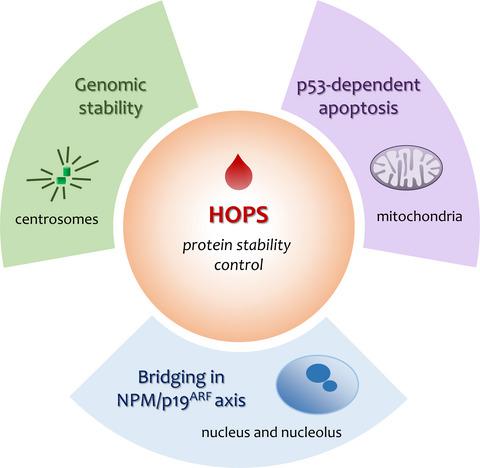Our official English website, www.x-mol.net, welcomes your feedback! (Note: you will need to create a separate account there.)
The Ins and Outs of HOPS/TMUB1 in biology and pathology
The FEBS Journal ( IF 5.4 ) Pub Date : 2020-08-29 , DOI: 10.1111/febs.15539 Maria Agnese Della-Fazia 1 , Marilena Castelli 1 , Danilo Piobbico 1 , Stefania Pieroni 1 , Giuseppe Servillo 1
The FEBS Journal ( IF 5.4 ) Pub Date : 2020-08-29 , DOI: 10.1111/febs.15539 Maria Agnese Della-Fazia 1 , Marilena Castelli 1 , Danilo Piobbico 1 , Stefania Pieroni 1 , Giuseppe Servillo 1
Affiliation

|
Liver regeneration represents an outstanding tool to study not only proliferation, but also other important processes such as inflammation, regenerative response or stem cell biology. Several novel genes have been identified as being involved in the proliferation of residual hepatocytes. One of them, HOPS/TMUB1, is proving to be a significant player in the control of proliferation, both contributing to genomic stability and as a partner of essential molecules. HOPS is an ubiquitin‐like protein, shuttling from nucleus to cytoplasm, and it is engaged in a number of biological and physiopathological functions. HOPS overexpression in tumour cell lines strongly reduces proliferation, arresting cell cycle in G0/G1. HOPS is involved in centrosome assembly and maintenance, and its knockdown causes genomic instability. Moreover, a direct interaction of HOPS with nucleophosmin (NPM) and p19Arf has been established, resulting in proper control of p19Arf stability and localization. These data indicate that HOPS acts as a functional bridge in the interaction between NPM and p19Arf, providing new mechanistic insight into how NPM and p19Arf will oppose cell proliferation. HOPS exerts a control in p53 stability, directing p53 mitochondrial apoptosis and cytoplasmic localization. HOPS plays a direct role as novel post‐translational modifier of p53, much like SUMO or NEDD. HOPS is overexpressed in a high number of human tumours in patients affected by large intestinal, CNS, liver and oesophageal tumours. This review highlights HOPS involvement in distinct cellular functions, establishing its role as a key player in cell biology and pathology in a broader context.
中文翻译:

HOPS / TMUB1在生物学和病理学中的来龙去脉
肝再生不仅是研究增殖的重要工具,而且是研究其他重要过程(例如炎症,再生反应或干细胞生物学)的杰出工具。已经鉴定出几种新基因与残余肝细胞的增殖有关。其中之一,HOPS / TMUB1,已被证明在控制增殖方面起着重要作用,既有助于基因组稳定性,又是必需分子的伴侣。HOPS是一种泛素样蛋白,从细胞核到细胞质穿梭,它具有许多生物学和生理病理功能。HOPS在肿瘤细胞系中的过度表达会强烈抑制增殖,从而阻止G 0 / G 1中的细胞周期。HOPS参与中心体的组装和维护,其敲低会导致基因组不稳定。此外,已经建立了HOPS与核磷脂(NPM)和p19 Arf的直接相互作用,从而可以正确控制p19 Arf的稳定性和定位。这些数据表明,HOPS在NPM和p19 Arf之间的相互作用中起到了功能性桥梁的作用,从而为NPM和p19 Arf的作用机理提供了新的机理见解。会阻止细胞增殖。HOPS控制p53的稳定性,指导p53线粒体凋亡和细胞质定位。HOPS作为p53的新型翻译后修饰子直接发挥作用,就像SUMO或NEDD一样。在受大肠,中枢神经系统,肝脏和食道肿瘤影响的患者中,HOPS在大量人类肿瘤中过表达。这篇综述着重介绍了HOPS在不同细胞功能中的参与,确立了其在更广泛的背景下作为细胞生物学和病理学中的关键角色的作用。
更新日期:2020-08-29
中文翻译:

HOPS / TMUB1在生物学和病理学中的来龙去脉
肝再生不仅是研究增殖的重要工具,而且是研究其他重要过程(例如炎症,再生反应或干细胞生物学)的杰出工具。已经鉴定出几种新基因与残余肝细胞的增殖有关。其中之一,HOPS / TMUB1,已被证明在控制增殖方面起着重要作用,既有助于基因组稳定性,又是必需分子的伴侣。HOPS是一种泛素样蛋白,从细胞核到细胞质穿梭,它具有许多生物学和生理病理功能。HOPS在肿瘤细胞系中的过度表达会强烈抑制增殖,从而阻止G 0 / G 1中的细胞周期。HOPS参与中心体的组装和维护,其敲低会导致基因组不稳定。此外,已经建立了HOPS与核磷脂(NPM)和p19 Arf的直接相互作用,从而可以正确控制p19 Arf的稳定性和定位。这些数据表明,HOPS在NPM和p19 Arf之间的相互作用中起到了功能性桥梁的作用,从而为NPM和p19 Arf的作用机理提供了新的机理见解。会阻止细胞增殖。HOPS控制p53的稳定性,指导p53线粒体凋亡和细胞质定位。HOPS作为p53的新型翻译后修饰子直接发挥作用,就像SUMO或NEDD一样。在受大肠,中枢神经系统,肝脏和食道肿瘤影响的患者中,HOPS在大量人类肿瘤中过表达。这篇综述着重介绍了HOPS在不同细胞功能中的参与,确立了其在更广泛的背景下作为细胞生物学和病理学中的关键角色的作用。


























 京公网安备 11010802027423号
京公网安备 11010802027423号